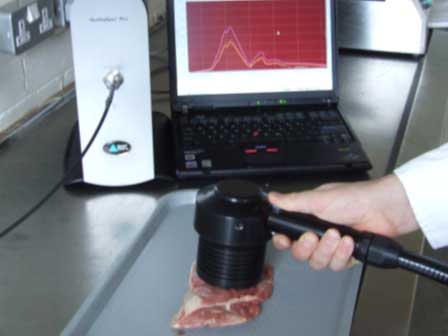Improving Meat Quality
Published on 24 June 2009 in Sustainability and Communities
Introduction
For Scotland to continue as a major producer and exporter of high quality beef and lamb it is essential that the meat produced meets market and consumer requirements. Improving product quality, by increasing lean meat output without a corresponding increase in fatness whilst maximising meat eating quality, will help to achieve sustainable economic growth for Scotland’s beef and sheep industries.
Establishing and evaluating accurate, reliable and objective techniques for measuring or predicting carcass and meat eating quality in beef cattle and sheep is a key step to the development of value-based marketing systems, genetic improvement programmes, and management systems to enhance product quality.
Key Points
In live animals, fat and muscle depths measured on the back by ultrasound scanning, or external dimensions measured by video image analysis (VIA), can be taken on-farm to predict important slaughter characteristics of beef and lamb. In live lambs, X-ray computed tomography (CT scanning) gives the most accurate predictions of carcass composition and also of intramuscular or marbling fat (a contributing factor to eating quality traits like juiciness and flavour), although no strong associations have been identified between in vivo CT measurements and other meat quality traits (e.g. tenderness, meat pH).
Product quality predictors that can be measured on the carcass include those estimated by VIA technology. This fast and non-invasive method provides accurate predictions of weights of trimmed primal cuts in beef and lamb. CT scanning of beef joints allows fast and accurate assessment of beef carcass composition, without damaging or devaluing the carcass and is recommended for use as a ‘gold standard’ for prediction of leanness. Moreover, CT-measured muscle density is moderately correlated to intramuscular fat content and its fatty acid composition.
One of the most promising techniques for assessing meat quality in these species is near infrared reflectance spectroscopy (NIR, Figure 1), which can predict fatty acid profiles, colour and sensory characteristics, such as texture, juiciness, flavour, and has the potential to be used on-line at the abattoir for fast and relatively inexpensive estimation of meat eating quality characteristics.

Figure 1: Near Infrared Reflectance (NIR) spectroscopy measurement of beef samples
Measurements taken by objective tenderometers, which assess force required to shear through a cooked meat sample, have also shown strong associations with sensory tenderness of beef assessed by a trained taste panel.
These measurements show genetic variation in different breeds and are thus of great interest for genetic improvement programmes, as well as for value-based marketing systems.
Research Undertaken
In addition to traditional measures of animal performance, such as live weight gain, Scottish Government-funded research at SAC is evaluating several current and novel technologies for predicting carcass and meat quality in beef and lamb, which have the potential to be used to select animals within breeding programmes (based on their own measurements and those of their relatives).
Animals from two divergent breeds of each species have been measured extensively pre- and post-slaughter. Live animal measurements included ultrasound scanning, CT scanning (sheep only) and video image analysis (VIA) of shape. Carcass measurements included VIA, pH, temperature, colour, CT scanning of joints of meat and Near Infrared Reflectance (NIR). Commercially-available DNA marker tests are being applied, and DNA samples stored for future analysis. Measurements are being tested against ‘gold standard’ laboratory-based methods and trained taste panel evaluations of sensory quality.
Understanding of the relationships among various predictor measurements, and between these measurements and carcass or meat quality traits, is increasing. This research will allow evaluation of the best technologies, or combinations of these technologies, to be used in genetic improvement programmes to select breeding stock that will improve the product quality of Scottish lamb and beef.
Policy Implications
Research has shown that genetic improvements in traits such as carcass quality, through selective breeding of animals with desired characteristics, leads to cumulative and permanent gains that could translate into substantial economic benefits for the Scottish livestock industries. These improvements in production efficiency could in turn result in more affordable meat products for consumers.
The application of some of these novel technologies also has the potential to be used by the industry as quality assessment tools, through which a future, value-based supply chain could be developed. This would allow producers to be rewarded for providing high product quality.
As well as measuring lean meat yield and meat eating quality attributes, this research is evaluating tools to measure levels of fat and different fatty acids in meat, and investigating the genetic basis of differences in these traits. These results could be used to genetically select beef cattle and sheep with lower levels of carcass fat and potentially favourable fatty acid profiles. Widespread use of genotypes with these attributes would reduce waste resulting from excess fat trim during processing, as well as resulting in healthy, high quality meat products.
Author
Dr Nicola Lambe nicola.lambe@sac.ac.uk
Topics
Sustainability and Communities







